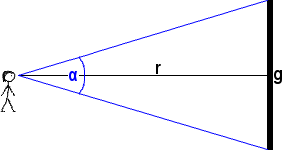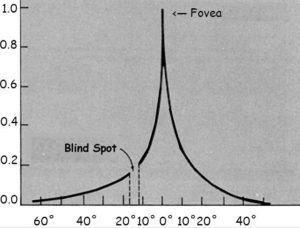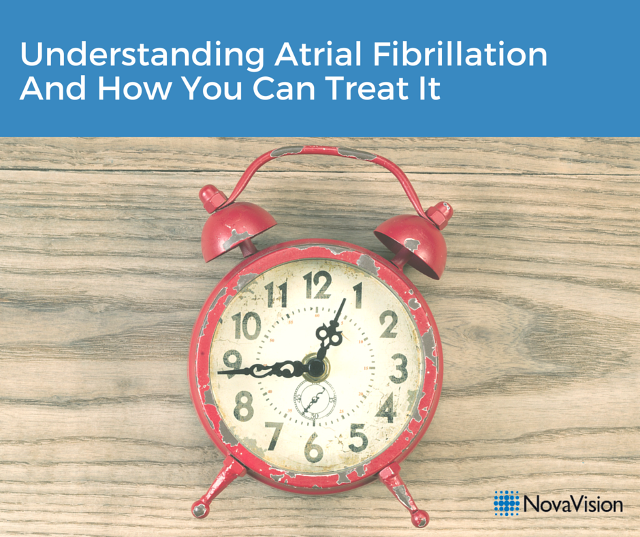An enlargement of the visual field by 5 degrees of visual angle – what does it really mean? Is that a lot or a little? Will it have a positive impact on my everyday living activities?
Every person who seeks information about NovaVision’s Vision Restoration Therapy, of course, wants to know how effective it is and how much vision they are likely to recover. On our website, you will see that a number of our clinical studies point to an enlargement of the visual field by an average of approx. 5 degrees of visual angle following the completion of 6 months of VRT.
The question you may have is what does that actually mean? What exactly is a degree (of visual angle), how many are there in total, and is 5 degrees meaningful or not?
To answer this you must understand that “degrees of visual angle” is the unit used to measure our visual field, i.e. the visible space around us. We all know from experience that if for example, we stand directly in front of a house and look straight ahead, we can maybe see the entrance door and a window. If however, we stand on the other side of the road, we can see the whole house and perhaps even the garage next to it. Our visual field thus widens at a greater distance and is therefore not measured linearly in meters or centimetres, but by means of the function of degrees that make up an angle.
The visual angle in physics and ophthalmology describes the angle that draws up from the eyes of the observer to the two endpoints of a distant object through virtual lines.
g = actual size of an object, r = distance to the object, α = visual angle (or apparent size)
How much we can identify and overlook at a certain visual angle depends on the distance of the corresponding image or object.
The visual field of both eyes together extends to 188 degrees (94 degrees each to either side), and the visual field of one eye extends to about 156 degrees. The visual fields of both eyes overlap in a large central area (124 degrees) making spatial vision possible. The vertical field extends to about 70 degrees up and about 80 degrees down. (These are standard values, which can differ significantly in individual cases).
However, in this complete visual field we do not see everywhere equally well. Think of the house you are looking at from the opposite side of the road: if focusing straight at it you will probably see the entrance door and windows in great detail, recognize the white latch on the dark blue door and the colourful flower pots on the window sill. However the picture not in the central field of view such as the garage at the side is likely to seem fuzzy, and to recognize the colour and brand of the car in the garage, you would definitely have to move your eyes (and possibly your head) in that direction to see it in your central vision. This is the way the retina of our eyes is constructed: only what we see directly with the fovea of the eye can we see sharply and detect all colours. The further an object is in the periphery of our visual field, the more obscure and “grey” it becomes. The following figure of the left eye shows how fast the visual acuity decreases towards the periphery.
In everyday life, we do not notice this frequently, because we are so used to constantly moving our eyes and our heads in order to see something new in our environment centrally, and by so doing we keep the picture of what we are looking at in clear focus. Often it is only the perception of a movement in the peripheral visual field which causes us to look at it immediately to find out whether this change in our environment is important to us and requires a reaction.
As previously mentioned the visual field of both eyes together overlap in a large central area (124 degrees) making spatial vision possible. Within this area the central area of 60 degrees – 30 degrees to the left and 30 to the right – is the “optimally usable visual field” (in terms of visual acuity, colour vision, spatial vision). For efficient reading, a “reading window” of about 5 degrees to the left and 8 degrees to the right of the fovea is required – due to our reading direction from left to right, the area on the right is slightly larger.
Given the above facts it should now become apparent that a 5 degree visual angle improvement following VRT can have a very meaningful impact on one’s daily activities. In case of, for example, loss of the right half of the visual field of both eyes (homonymous hemianopia to the right), Vision Restoration Therapy targets the central area of 43 (2x 21.5) degrees horizontally and 32 (2×16) degrees vertically – all improvements shown in the studies were found in this area.
While an improvement of 5 degrees of visual angle at the far end of the peripheral visual field would only play a minor role in everyday vision and might not even be noticed at all, such an improvement in the central area – where VRT is applied – can have a significant impact.
Many of our patients reported that they had major difficulty in reading their daily newspaper or book before they started VRT and after completion were again able to read without a problem – an improvement of 5 degrees of angle in the area of the reading window as described is fully sufficient to restore this type of daily activity.
Other activities reported in the clinical studies and in our daily interaction with patients that benefit from an improvement of central visual angle include: needle work, handicrafts, cooking and food preparation, hairdressing and make-up; and at a slightly larger distance computer work and television. Others had lost stereoscopic vision because the visual fields of both eyes did not overlap sufficiently any longer, but regained stereoscopic vision after VRT completion.
Also bear in mind that the average improvement of 5 degrees of visual angle measured in the studies is precisely this: the average outcome of all the study subjects together, which can be very different in each individual. While sometimes no improvements can be detected following VRT, others experience an enlargement of their visual field by much more than the average. In fact it is not uncommon that after completion of VRT a patient suffering from homonymous hemianopia (loss of half one’s visual field), restores the vision completely in at least one of the quadrants of lost vision. If the lower quadrant improves, the person can safely move around, sees obstacles on the ground in front of their feet, can safely climb or descend steps. If the upper quadrant improves, the person experiences a larger overview at distance and can find their way for example in a crowd such as at a railway station, or in a department store.
Each person experiences his or her visual impairment in a different way and each therapy course with VRT is individual. Every type of visual improvement has different effects and is valued differently from person to person. What is certain, however, is that after completion of VRT many patients have achieved a significant improvement of their vision and their quality of life so five degrees is actually a big deal!
You can take our free online vision test here to properly determine the presence of a visual defect, the results of this free vision test should be combined with a complete vision evaluation with a medical professional.
If you would like to learn more about our Vision Restoration Therapy you can contact us here and someone from our patient services team will call you and answer any questions or walk you through our therapy process.
Written by: Sigrid Kenkel





Recent Comments